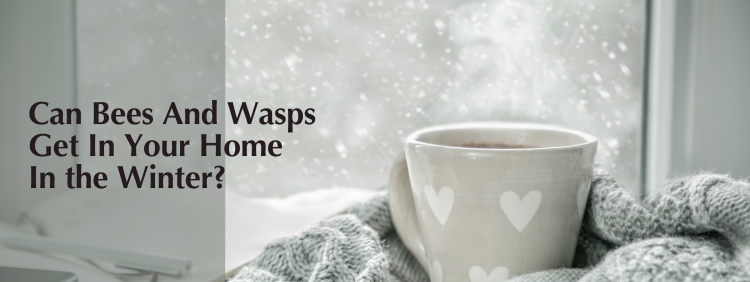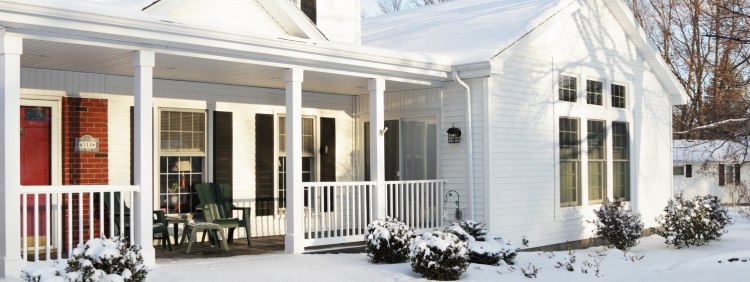Can Bees And Wasps Get In Your Home In the Winter

Winter is here, and as the temperatures plummet, there’s an unanticipated question niggling at the back of your mind—can bees and wasps get in your home during winter? It may sound like a scene from a quirky horror movie, but the reality can be surprising. And if they do find their way into your home, you will need to know about our professional pest removal services.
The Winter Hive
Ever wondered where bees and wasps fly off to when we button up in our cozy homes for the winter? Let’s go on a fascinating journey into their world.
For most bee species, including honeybees and bumblebees, preparation for winter begins as early as late summer. They store surplus food (nectar and pollen) to ensure the survival of the colony. Interestingly, honeybees huddle together, creating a ‘winter cluster’ within their hive to stay warm. They take turns moving from the outer part of the cluster to the centre, where it’s warmer, cleverly bolstering survivability.
However, wasps, such as yellow jackets and hornets, have a starkly different winter strategy. Only fertilized queens survive the winter by finding a snug overwintering site (often in a hollow log or a burrow). The rest of the colony sadly, dies off. As colder weather sets in, the queen enters a dormant phase until spring arrives.
Believe it or not, sometimes your home is just the overwintering site the queen wasp or a swarm of bees was looking for!
The queen wasp or bee, after mating in the late summer or early autumn, will seek out a safe and warm place to spend the winter months. Unfortunately, your home might just fit the bill perfectly. The crevices of your walls, the comfort of your attic or even the coziness of your basement are all favourable spots these buzzing ladies might consider their winter retreats.
Sealing the Cracks
Typically, vents function as important entry points. Wasps or bees might squeeze through these spaces to settle into your home’s interior. Regularly inspect your vents for any signs of nests or buzzing activity. If you find anything suspicious, it’s better to act sooner rather than later.
The chimney is another common entry point. Particularly if you are not using your fireplace frequently during the winter. This offers a quiet, dark and warm space for insects to build nests. If possible, consider installing a chimney cap. This not only closes off a potential entry point but also prevents nests from blocking your chimney.
Of course, windows and doors often serve as entrances for these flying pests. As these creatures are small and agile, even the tiniest gaps around windows or under doors can provide access. Remember to keep your windows and doors properly sealed, especially during the colder months. Weather stripping can be an effective solution to close these gaps.
Finally, cracks or crevices in the walls or foundation of your home are also potential gateways for these buzzing intruders. The winter weather can cause the structures of your home to contract and expand, leading to the creation of these gaps. Regular maintenance and prompt sealing of these areas can go a long way in keeping your home insect-free.
Buzzing Intruders: Identifying Nests in Your Home
Bees and wasps, while distinct species, share certain habits when it comes to nest building. Both insects build nests using organic materials available in their environment. However, the structure and location of these nests vary, giving you a clue about the invader’s identity.
Let’s look at them individually:
Identifying Bee Nests
Bees, particularly honey bees, construct nests that are simply more than homes; they are complex structures designed to support a colony’s honey production. The nests have a distinct feature honeycomb, a grid of hexagonal cells made of beeswax. They typically establish their nests in hollow trees or rock crevices, but they can also opt for your home’s wall structures. Don’t look for a hive hanging in a tree; that’s a common misconception.
Unlike honey bees, bumblebees prefer the ground. They are often found nesting under decks, patios, and sheds. If you see bees entering a hole in the ground or a crack in your wall, it’s likely a bumblebee nest.
Recognizing Wasp Nests
Wasps, on the other hand, tend to be less choosy about their nesting location, and they do not produce honey. They build paper-like nests from chewed wood pulp, often resembling a grey or brown papery balloon. Common places you’d find a wasp nest in your home include the attic, garage, or any quiet, secluded area.
To understand a situation, observe without disturbing. If wasps are frequently seen in a particular area at your home, it could be a sign of their nesting location. Be careful, though. Wasps can be aggressive when their nests are disturbed.
Remember: It’s essential to positively identify a nest because the removal method varies for each. Be especially cautious if you suspect a wasp nest as wasps can become hostile during a removal attempt. In such a case, professional help may be necessary.
To avoid harm to yourself or the insects, particularly bees, which play an important role in our ecosystem, it’s always best to reach out to Truly Nolen professionals for assistance if you identify a nest in or around your home.
Enjoying Winter Without Intruders

If you can prevent these pests from turning your home into their winter hideout, it’s the best-case scenario. But what if you’ve already spotted some buzzing intruders enjoying your cozy environment? What do you do then?
If you find a bee or wasp inside your home, your initial reaction may be to squash it. However, this is not the best course of action. Squashing the insect can actually release a pheromone that will attract others of its kind to your house. Instead, you should try to gently guide it toward a window or door so that it can find its way back outside. This is a much safer way of dealing with the problem and will also help to ensure that you don’t end up with a whole swarm inside your home.
Seeing these stinging insects in your home can be a cause for concern, but it doesn’t always mean you have an infestation. It’s important to keep in mind that these insects may have entered your home by mistake and are simply looking for a way out. However, if you start to see them more frequently or in larger numbers, this could be an indication that there’s a nest nearby. At this point, it’s best to contact a professional pest control company like Truly Nolen to locate the source and take appropriate measures to eliminate the problem.
Don’t wait until it’s too late and the problem becomes overwhelming; reach out to the experts at Truly Nolen for assistance today.
When to Call in the Exterminators for Removal Services
Even though we’ve suggested prevention techniques earlier in the article, there are situations where it’s best to leave bee and wasp removal to the professionals. The rule of thumb is safety always comes first. Allow us to guide you through identifying some of the circumstances that necessitate the need for professional extermination services.
Severity of infestation:
If you’re dealing with multiple nests or a large swarm, it may be beyond your capability to handle the situation safely on your own. More nests mean more wasps or bees to contend with, increasing the risk of painful stings or a possible allergic reaction. In this case, professional pest control services can perform a thorough inspection and remove the problem effectively and safely.
Inaccessible nests:
These insects are known for building their nests in the most inconvenient locations, often in nooks and crannies that are hard to reach. If their nest is somewhere high or in a tight spot like within the walls or the eaves of your home, it increases the level of difficulty and danger of the removal process. Professional exterminators have the appropriate gear and expertise to deal with these arduous scenarios.
Species identification:
Another crucial consideration when deciding whether to remove a nest on your own is correctly identifying the species you’re dealing with. Not every bee and wasp species poses the same level of threat to humans, and some are actually protected species due to their essential role in local ecosystems. Misidentifying the species can lead to unnecessary harm to beneficial insects and potential legal repercussions. Pest control professionals have the training to make accurate species identifications and handle the insects appropriately.
So, before you put on that makeshift beekeeper suit and arm yourself with a spray can, take a moment to assess the situation. If the task seems too daunting or dangerous, it may be time to call in the experts at Truly Nolen. With years of experience and proper licensing, we have the expertise needed to safely and effectively remove these insects from your property. We take pride in our commitment to environmentally friendly practices, ensuring that our solutions are not only effective but also sustainable. Contact Truly Nolen for all of your pest removal needs.